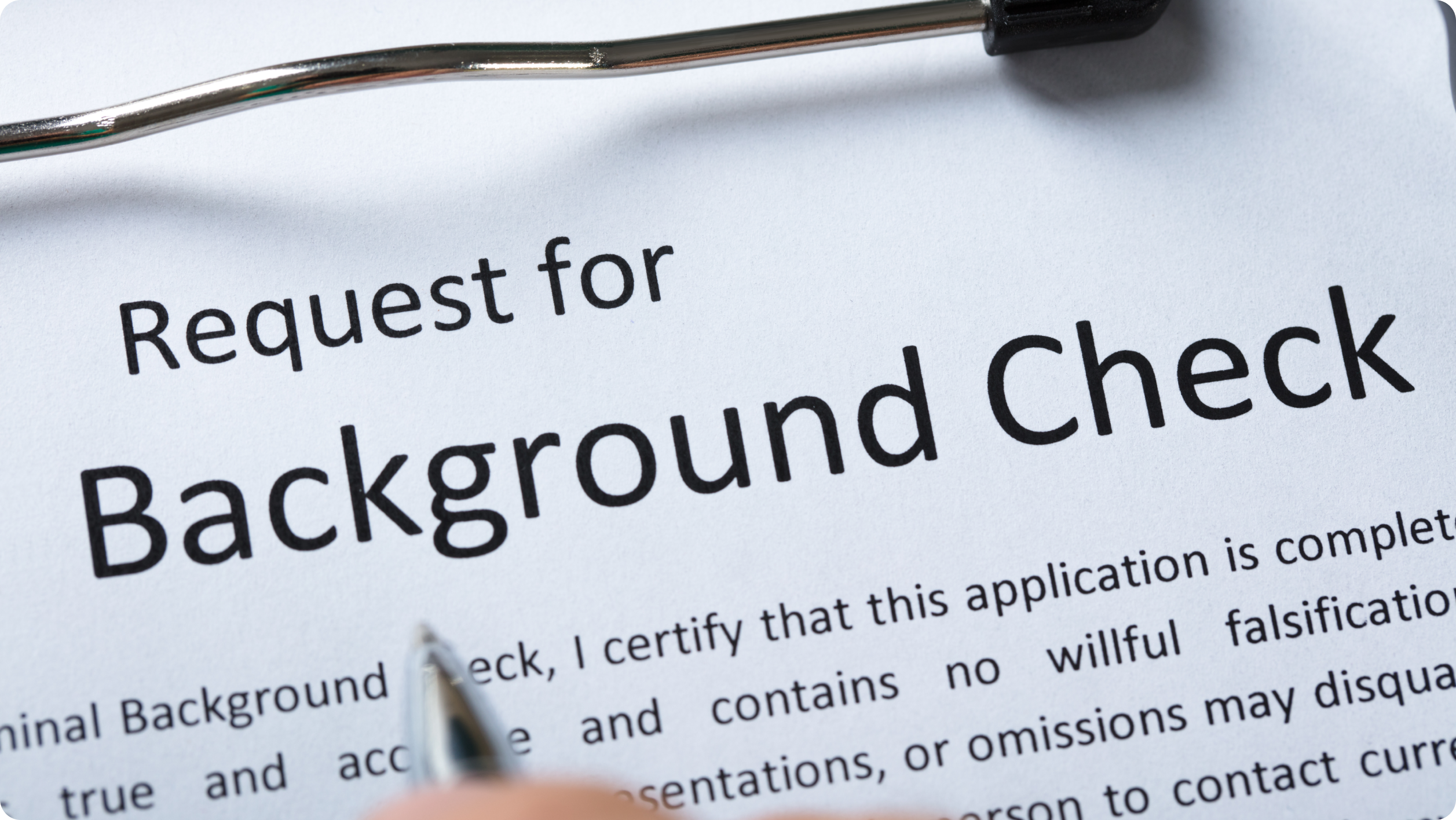According to Princeton University’s Eviction Lab, 3.6 million eviction cases are filed annually. If you don’t want to be part of that statistic, tenant screening can make all the difference.
But what exactly should you screen for? It’s easy to miss important details when evaluating potential tenants. Using a tenant screening checklist will help you cover all the bases and make sure applicants meet all your rental criteria before handing over the keys.
In this guide, we’ll discuss all the essentials for tenant screening, from key questions to the documents you need to request. We’ve also included a sample landlord screening checklist to help you get started immediately.
Key takeaways:
- A thorough tenant screening process minimizes risks, such as late payments, lease violations, and costly evictions.
- Verify credit, criminal, and eviction history, along with income and rental references, to find reliable tenants.
- Use a tenant screening checklist to stay organized, follow consistent criteria, and ensure all important steps are covered.
- Clearly communicate fees, deposits, and rules to avoid misunderstandings with tenants.
- Use tenant screening tools like Baselane to get free comprehensive reports in minutes, including credit, criminal, eviction, income, and identity checks.
Tenant screening criteria checklist
Before you start accepting rental applications, you should know what kind of tenant you want to live in your property. Follow the Fair Housing Act when setting rental criteria to avoid any discriminatory practices.
Here are examples of fair tenant screening criteria:
- Income: Monthly income must be three times the rent amount.
- Credit score: A minimum credit score of 650 is required.
- Rental history: No evictions recorded in the last five years.
- Employment: Proof of current employment (at least six months) or two years of tax returns if self-employed.
- Criminal background: No violent crimes in the past seven years.
Landlords should evaluate all applicants using the same criteria. This ensures you treat all tenants fairly and helps prevent bias and discrimination.
Rental application checklist
A rental application is a form that collects all the key information you need from potential tenants. It’s the first step in screening rental applicants to determine if they’re a good fit for your property.
Here’s the information you’ll need to collect on a rental application form:
- Government-issued photo identification: A valid photo ID, such as a driver’s license or passport, to confirm the person applying is who they claim to be.
- Social Security Number or Taxpayer Identification Number: Helps verify the applicant’s identity for credit and tenant evaluation background checks. A Taxpayer Identification Number (TIN) may indicate they’re not a U.S. citizen but still eligible to rent.
- Recent pay stubs (last 2-3 months): Pay stubs provide proof of consistent income from an employer. Self-employed individuals can provide tax returns.
- Bank statements (last 2-3 months): Bank statements offer a clearer picture of financial habits and savings. They can also confirm deposit amounts match the income they claim.
- Personal references: Personal references can provide insight into the applicant’s character. These are often roommates, friends, or family who can vouch for their reliability.
- Rental history (past addresses for 2+ years): Knowing where they’ve lived helps you identify patterns, like frequent moves or gaps in residence. Frequent moves can be a red flag.
- Contact details for previous landlords: This helps you confirm the applicant’s rental history and past behavior. Double-check the contact details and always follow up with a quick call or email.
- Reason for leaving current residence: Understanding why they’re moving can reveal important details, like changing jobs or financial struggles.
- Consent for a background check: This is required for checking criminal history and eviction records. Certain states limit how you can use this information for selecting or denying tenants.
- Consent for a credit check: Running a credit check on a tenant reveals their financial responsibility, including debts and payment history. Written consent is required for legal reasons.
Tenant income requirements checklist
Landlords must follow federal laws like the Fair Housing Act (FHA) and the Equal Credit Opportunity Act (ECOA), which prohibit discrimination and require equal treatment of all income sources, including public assistance.
Some states and cities also have Source of Income (SOI) protections to prevent discrimination based on how applicants earn their income.
Here are the key steps to properly check a tenant’s income while staying compliant with these laws:
- Monthly income: A general rule of thumb is that tenants should earn three times the monthly rent. Expensive cities might require closer to 4x the rent. A recent Harvard study reports that 22.4 million U.S. households spend over 30% of their income on rent, with half exceeding 50%.
- Proof of stable income source: Request pay stubs, W-2 forms, or bank statements to confirm income. Be cautious of job-hopping or irregular work patterns that could indicate financial instability. When renting to elderly tenants, verify income sources like Social Security, pensions, or savings.
- Tax returns for self-employed applicants: For self-employed applicants, tax returns from the past two years can verify income. Bank statements from the same period can confirm the income on their tax returns.
- Verification of additional income sources: Some tenants may rely on additional income sources (e.g., alimony or child support). Verify these by requesting legal documentation, like court orders or official award letters.
- Letter from a guarantor (if applicable): If a tenant doesn’t meet the income requirements, they may provide a guarantor who will cover the rent if needed. Request a signed letter from the guarantor or add them as a cosigner on the lease agreement.
- Guarantor’s proof of income: Treat a guarantor like an applicant by verifying their income. Request recent pay stubs, tax returns, or bank statements to confirm they can pay the rent if the tenant falls behind.
Don’t rely on self-reported income, which can easily be faked. Choose a tenant screening service that verifies income sources and documents.
Tenant credit checklist
A credit check shows how reliable applicants are with money based on their history of managing debt and making payments on time.
Here’s a checklist of what landlords look for in a credit report:
- Credit score: A score ranging from 300 to 850, providing a quick snapshot of an applicant’s financial health.
- History of late payments: Review the applicant’s history of making timely payments for loans, credit cards, and other obligations.
- Credit card debt balance: Check the total amount of credit card debt the applicant carries.
- Loan obligations: Evaluate the applicant’s other monthly obligations, like car loans, student loans, or personal loans. These commitments reduce the income available for rent payments.
- Bankruptcy or collections: Check if the applicant has collection accounts or bankruptcy filings. A past bankruptcy or collections balance indicates financial difficulties, but it doesn’t necessarily mean they’re currently struggling.
Here’s a simple step-by-step process to verify a tenant’s rental history.
Tenant background checklist
A background check is crucial for landlords looking to avoid bad tenants who might disrupt the property or community.
Here’s a checklist to guide you through a thorough tenant background review:
- Criminal record check: A criminal record check reveals past convictions, including felonies, misdemeanors, and pending charges.
- Sex offender registry check: Verifies whether the applicant is listed in the National Sex Offender Registry.
- History of evictions: An eviction can indicate past problems with paying rent or following lease terms. Evictions can affect credit scores if they’re reported as debt in collections or a court judgment.
- Civil court judgments related to housing: Review any civil court records for judgments involving unpaid rent, property damage, or other landlord-tenant disputes.
Check local laws about what you’re allowed to include in a background check. Baselane’s tenant screening tool makes this easy, providing state-compliant reports with results from over 1.8 billion criminal records in more than 2,500 jurisdictions and the largest database of eviction records.
Comprehensive reports you can trust, delivered in minutes.
Rental history checklist
A rental history check provides valuable insights into a potential tenant’s past rental behavior. Did they pay rent on time? Were there any disputes with previous landlords?
Here’s a checklist to ensure you cover all the key points when reviewing an applicant’s rental history:
- Consistent on-time rent payments: Check if the tenant usually pays their rent on time or routinely misses the due date.
- Complaints or disputes with landlords: Ask previous landlords about any complaints or disputes with the tenant.
- Lease violations (e.g., unauthorized pets, subletting): Check if the tenant has violated lease terms and whether those issues are resolved or ongoing.
- Length of tenancy at previous residences: How long has the tenant stayed at previous rentals? Short-term stays aren’t always bad—ask why they moved. Job changes or life events can be legitimate reasons.
Household questionnaire checklist
Information about a tenant’s living situation can help you decide if they’re a good match for your property and aligned with rental requirements.
Here’s what to include in a tenant’s household questionnaire:
- Number of occupants: Ask how many people will live in the unit. Clarify if additional occupants might move in later, such as partners or relatives.
- Names and details of all adult tenants: Request the names and basic details (e.g., age, employment status) of every adult who will live on the property. Each adult should complete a separate rental application and undergo screening.
- Number of children (if any): Avoid asking intrusive questions about children’s ages or school enrollment unless it directly impacts lease terms (e.g., noise restrictions or play areas).
- Pets: If your property allows pets, gather details about the type, breed, size, and number of animals. Consider requiring a pet deposit or pet rent to cover potential damage.
- Vehicles (make, model, license plate): Ask about the vehicles the household will park at your property.
Personal requirements checklist
In addition to checking rental, criminal, and credit history, there are some personal and rental requirements for landlords to confirm with new tenants.
- Emergency contact information: Request an emergency contact in case of accidents or urgent situations involving the tenant.
- Proof of renter’s insurance (if required): The renter’s insurance protects both you and the tenant by covering damages to personal belongings and liability in case of accidents.
- Smoking policy compliance: Confirm that tenants understand and agree to your smoking policy.
- Agreement to property rules: Provide a written copy of the rules as part of the lease to avoid misunderstandings later.
- Agreement to maintenance responsibilities: Include these responsibilities in the lease agreement and provide instructions or contacts for handling maintenance issues.
Rental fees and deposits checklist
Here’s a breakdown of the common fees and deposits to include in your rental process:
- Application fee: This fee (typically around $50) covers the cost of running background and credit reports for rental applicants. It’s typically non-refundable.
- Security deposit: The security deposit acts as a safety net for damages or unpaid rent. It’s usually equal to one month’s rent but varies by state.
- First month’s rent: Collect the first month’s rent upfront to secure the lease.
- Last month’s rent (if applicable): Some landlords request last month’s rent in advance as additional security.
- Pet deposit (if applicable): If you allow pets, a pet deposit covers potential damages caused by them. It’s usually refundable if no damage occurs.
- Key deposit: A key deposit ensures tenants return all keys at the end of the lease.
- Utility connection: If rent includes any utilities (cable, internet, electricity, water), there’s usually a one-time connection fee to set up these services.
Lease agreement and legal compliance checklist
Lease agreements outline the duration of tenancy, monthly rent, and other essential terms. Here’s what to do when you get to this step:
- Review and sign the lease agreement: Go over the lease agreement with the prospective tenant to ensure they understand all terms and conditions. Once reviewed, both parties should sign the document to make it legally binding. Provide a copy of the signed lease for the tenant’s records, and keep one for yourself.
- Confirm the lease duration: Clarify the duration of the lease term. The most common lease length is 12 months.
- Agree to renewal terms: If you offer a lease renewal, outline the terms, including any rent increases or changes.
- Agree to late payment penalties: Clearly explain rent due dates and penalties for late rent payments, including fees and grace periods.
- Confirm the move-in date: Establish a clear move-in date and plan for any necessary preparations, like cleaning or repairs.
- Comply with local laws: Include state regulations in your lease for rent payments and deposits, evictions, landlord-tenant responsibilities, and other terms.
Property-specific requirements checklist
Each rental property comes with its own set of rules and guidelines that tenants must follow to ensure a smooth living experience.
Here’s what to include in a landlord’s checklist for new tenants:
- Agreement to HOA rules (if applicable): If the property is part of a homeowners’ association (HOA), tenants must agree to follow HOA rules, such as noise restrictions or landscaping guidelines.
- Parking policy compliance: Clarify parking rules, including assigned spaces, visitor parking, and restrictions on oversized or additional vehicles.
- Utility responsibilities: Specify which utilities the tenant is responsible for paying and which are covered by you.
- Compliance with waste disposal policies: Explain the rules for waste disposal, including designated bins, recycling requirements, and pickup schedules.
- Use of amenities (e.g., pool, gym): If the property includes shared amenities, outline the rules for their use, such as operating hours and guest policies.
- Agreement to inspection and maintenance access: Tenants must agree to allow reasonable access for inspections, repairs, and maintenance as outlined in the lease.
Sample tenant screening checklist PDF
A landlord-tenant screening checklist is designed to help you stay organized so you don’t miss any important steps in your rental criteria.
This free tenant screening checklist template is formatted for easy printing or digital use, so you can check off items as you go.
Streamline tenant screening with Baselane
Proper tenant screening minimizes the chances of facing issues like evicting squatters. But let’s face it—going through all these steps on your own can be overwhelming.
Baselane simplifies the entire process and delivers the most comprehensive tenant screening reports available in minutes—100% free for landlords. These reports include rental applications, bank-verified income and advanced ID checks, a full Equifax credit report, and the largest database of eviction and criminal history. Get started for free today!
FAQs
Yes, landlords can charge an application fee to cover the cost of screening. However, some states limit how much you can charge, so always check local laws.
If the tenant is a first-time renter, focus on other aspects of their application, like income, credit score, and references. You may also ask for a guarantor to ensure rent payments.
It's not generally required but is a good idea if their circumstances have changed significantly, such as a job change or new occupants in the household.
If you discover false information during screening, you can deny their application. Ensure the denial is documented and compliant with all applicable laws.
When screening tenants, check their credit history, criminal background, and eviction records. Verify their income stability through pay stubs or bank statements, confirm rental history with previous landlords, and ensure their application includes accurate personal and identification details.
Baselane does this all for you, delivering comprehensive screening reports in minutes that are completely free for landlords.
Tenant screening details vary based on the service. With Baselane, you’ll instantly receive complete 360-degree tenant screening reports that include:
- Rental application: Income, housing history, dependents, pets, vehicles, smoking, and more.
- Credit report: Including scores, payment history, and outstanding debts.
- Criminal background check: Felony, misdemeanor, and sex offender records.
- Eviction history: Past evictions or rental disputes.
- Income verification: Proof of income through a tenant’s bank, payroll provider, or documents.
- Rental history: Past addresses and landlord references.
- ID verification: Database check, facial recognition, and document scanning that supports 16,000+ ID types and 200+ countries.
A rental walkthrough should be done before tenants move in and after they leave. Here’s what a move-in/move-out checklist should include:
- Property condition: Note the state of walls, floors, fixtures, and appliances.
- Utilities and systems: Test plumbing, HVAC, and electrical systems.
- Keys and locks: Verify functionality and provide or reclaim necessary keys.
- Safety equipment: Check smoke detectors, carbon monoxide alarms, and fire extinguishers.
- Photos or video documentation: Capture evidence of the property's condition for records.
A first-time landlord-tenant screening checklist should include:
- Rental application: Collect personal, employment, and rental history details.
- Credit check: Assess financial reliability and debt levels.
- Background check: Review criminal and eviction history.
- Income verification: Confirm stable income meets rental requirements.
- References: Contact previous landlords and personal references.
- Lease and fees: Review lease terms and collect move-in fees.
- Rental requirements: Explain property rules and tenant responsibilities.








